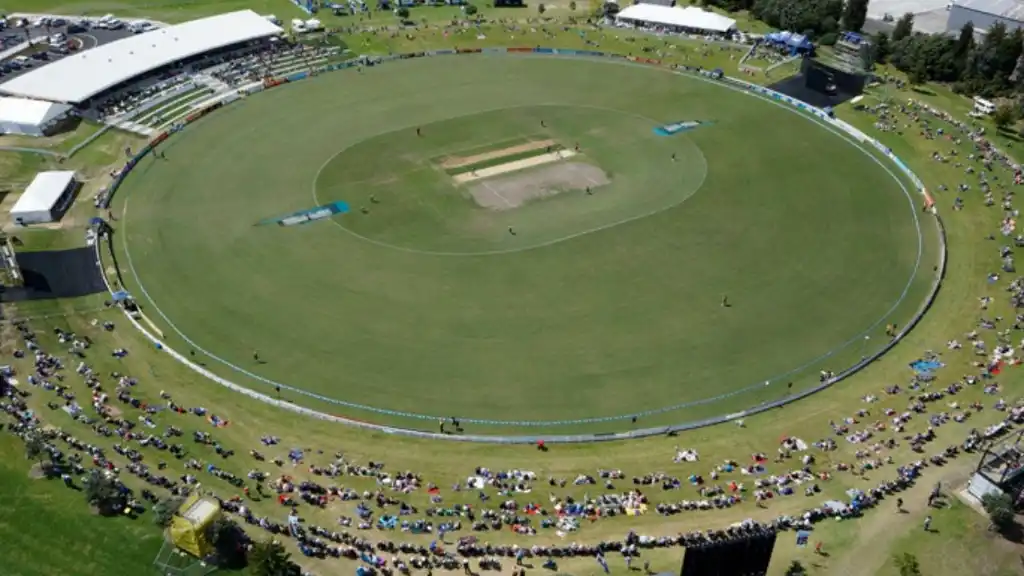- Venue: Bay Oval, Mount Maunganui
- Date: 1 October 2025
- Time: 7:10 PM (local time)
Stadium Overview
Bay Oval in Mount Maunganui is one of the most picturesque cricket venues in New Zealand. Opened in 2005, it has a seating capacity of over 10,000 spectators. Located near the beach, the stadium offers a unique and pleasant atmosphere. This match marks the beginning of Australia’s tour of New Zealand 2025–26 with a three-match T20I series.
Pitch Characteristics
The Bay Oval pitch is regarded as a paradise for batters. Known for its true bounce, it allows players to trust the surface and play their shots with confidence.
Batting-Friendly Conditions
This ground has a reputation for producing high-scoring T20 encounters. The pitch is flat and firm, which helps the ball come nicely onto the bat. During the powerplay, batters can play aggressively and take full advantage of the fielding restrictions. With medium-sized boundaries, hitting fours and sixes becomes easier.
The average T20 score here ranges between 165–180 runs, but a strong batting side can easily push the total beyond 200.
Challenges for Bowlers
Fast bowlers get only limited help from this surface. Some swing may be available early on, but the pitch flattens quickly. Bowlers need to vary their lengths and lines to be effective. At the death, slower deliveries and yorkers become crucial.
Spinners may find some assistance in the middle overs, especially in the second innings. However, they must rely on variations in pace and accuracy to contain batters.
Similar: India vs West Indies 1st Test Match 2025 – Pitch Report, Narendra Modi Stadium
Weather Conditions
Early October in Mount Maunganui brings cool and dry weather. The temperature is expected to stay between 15–20°C. Since the game will be played in the evening, dew is likely to be a factor, making it difficult for bowlers in the second innings. The sea breeze may help pacers a little, while the chances of rain are minimal.
Toss Factor
At Bay Oval, winning the toss and batting first is often considered advantageous. Historically, teams batting first have had better success at this venue. In evening matches, dew makes bowling in the second innings more challenging.
However, chasing is not impossible. Teams must focus on not losing early wickets and building momentum steadily.
Boundary Dimensions
Bay Oval has ideal boundary sizes for T20 cricket. The square boundaries are about 60–65 metres, while the straight boundaries extend to around 70–75 metres. This provides batters with ample opportunities for big hits. Fielders, however, need to stay sharp as the ball reaches the boundary quickly.
Team Strategies
For New Zealand
Playing in home conditions, New Zealand will rely on their experienced players. Despite the absence of a few key names, they need to play positive cricket. Smart use of spinners and sharp fielding could make the difference.
For Australia
Australia always brings aggression to the trans-Tasman rivalry. They will aim for quick runs at the top while ensuring they don’t lose too many wickets early. Bowlers must remain disciplined and avoid conceding extras. Their traditionally strong fielding unit could also give them an edge.
Key Points
- Bat First Advantage: Teams winning the toss prefer to bat first.
- High Scores Expected: A total of 180+ is considered competitive.
- Powerplay Crucial: Maximising runs in the first six overs is essential.
- Dew Factor: Bowling in the second innings could be challenging.
- Role of Spinners: Maintaining economy in the middle overs is key.
Conclusion
The Bay Oval clash is set to be a thrilling, high-scoring contest. With the pitch tilted in favour of batters, fans can expect an entertaining game filled with boundaries and sixes. Both sides have strong batting and bowling resources, ensuring a balanced competition. New Zealand may enjoy a slight edge at home, but Australia’s experience and aggressive style will keep the contest exciting.



